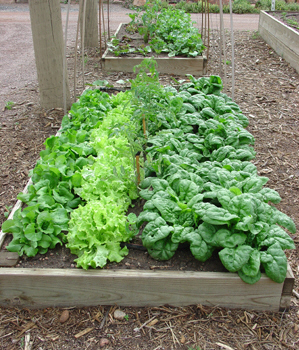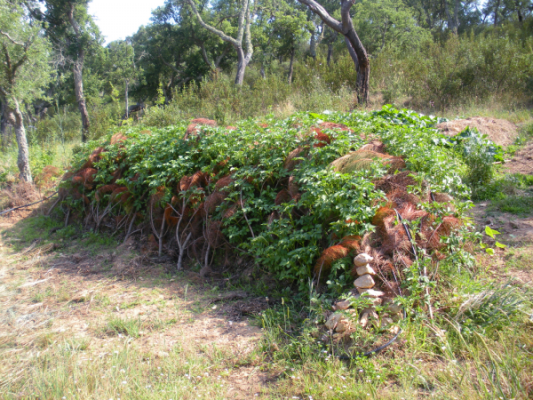The Hugelkultur and Raised Bed Garden Designs
There are a plethora of unique garden bed designs. Most of these set ups allow you to maximize space and minimize costly inputs such as fertilizers and chemical pesticides.
Here’s a couple of garden bed designs which are cheap to build and yet very effective and productive ways to garden.
 The Raised Bed
The Raised Bed
The basic structure is four wooden boards- I have two raised beds each made of two 11′ boards long by two 8.5′ wooden boards. These boards were then laid into shallow trenches and screwed together with brackets in four corners; thus making a square or rectangle depending on the dimensions. Then I put landscaping cloth put over top of the ground inside the bed then covered the cloth with top soil and compost; the raised bed is now ready for use.
There are many variations on this form- some beds are covered first in landscaping cloth then covered with newspaper or mulch which helps discourage weed growth and pests more effectively together. Still, some people make a “lasagna” garden which consists of layers of well- rotted compost or manure, grass clippings or fruit and veggie waste that is sandwiched between layers of wood chips, leaves or anything containing a good amount of carbon. This pile is then left to rot and compost for a season or two. After the wait the garden bed is teeming with organic material and micro-organisms, a great place to grow a bounty of crops. This technique allows gardeners to make use of what materials they have on hand, but the process of breaking down layers takes time. All of these raised beds are durable, easy to manage and are great foils for setting up season extending hoop houses.
 The Hugelkultur:
The Hugelkultur:
Hugelkultur mimics the natural forest floor by using rotting logs, leaves and compost. The components of this type of bed help hold in moisture and raise the soil temperature. These raised beds require more space than the traditional raised beds and are time consuming to set up. However, these beds are very effective season after season.
The structure of a Hugelkultur is very involved- and there are many variations too. The basic form consists of small to medium fire log sized pieces of wood laid in a half circular pile, which is piled with fall leaves or straw, after that green leaves or grass clippings are added. Then mature compost is mounded on top of the mixture. The idea being that as the logs and leaves and grass break down they will enrich the soil and hold moisture more effectively. The wood breaks down into a spongy, springy material that soaks and holds any sort of moisture- from the air or from raindrops. I have seen setups where the gardener digs a trench, fills it with logs and leaves and then fills the trench with the dug up soil and adds some type of soil enriching compost.
This style of garden bed can be very cost efficient- it’s one of the cheapest and most effective garden beds around if you have access to all the resources. However this style bed would do best in humid and rainy climates, though arid climates have found ways to redesign the Hugelkultur to work within their environment.
This is the first part in a two part series on garden designs. You can read the second part here.




